|
Author
|
Topic: Whodunnit?
|
rnelson
Member
|
 posted 05-07-2008 11:02 AM
posted 05-07-2008 11:02 AM
  
A mock crime demonstration. The test is a CIT, with three volunteer suspects who were given separate instructions and then tested in front of a room full of snickering social workers (i.e., people making funny faces and throwing paper airplanes at them). For simplicity, all the key items are at R3. Also, include the last question C75 as one of the padding questions. There are lots of things to think about in front of a room full of people, and I missed that question tag. Suspect 1 
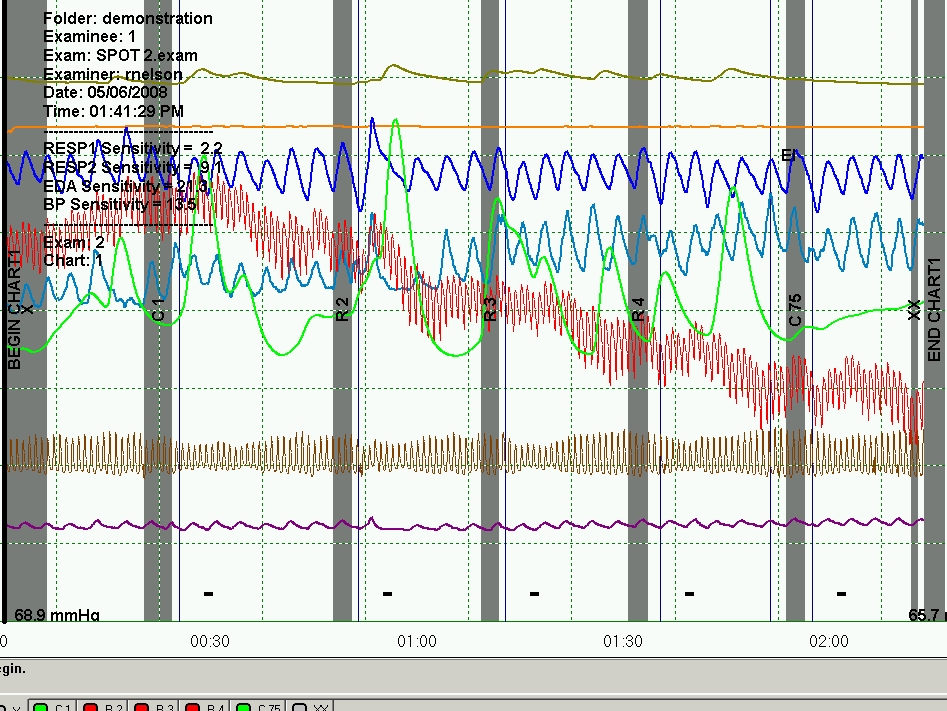

enjoy,
r
------------------
"Gentlemen, you can't fight in here. This is the war room."
--(Stanley Kubrick/Peter Sellers - Dr. Strangelove, 1964)
IP: Logged |
rnelson
Member
|
 posted 05-07-2008 11:03 AM
posted 05-07-2008 11:03 AM
  
Suspect #2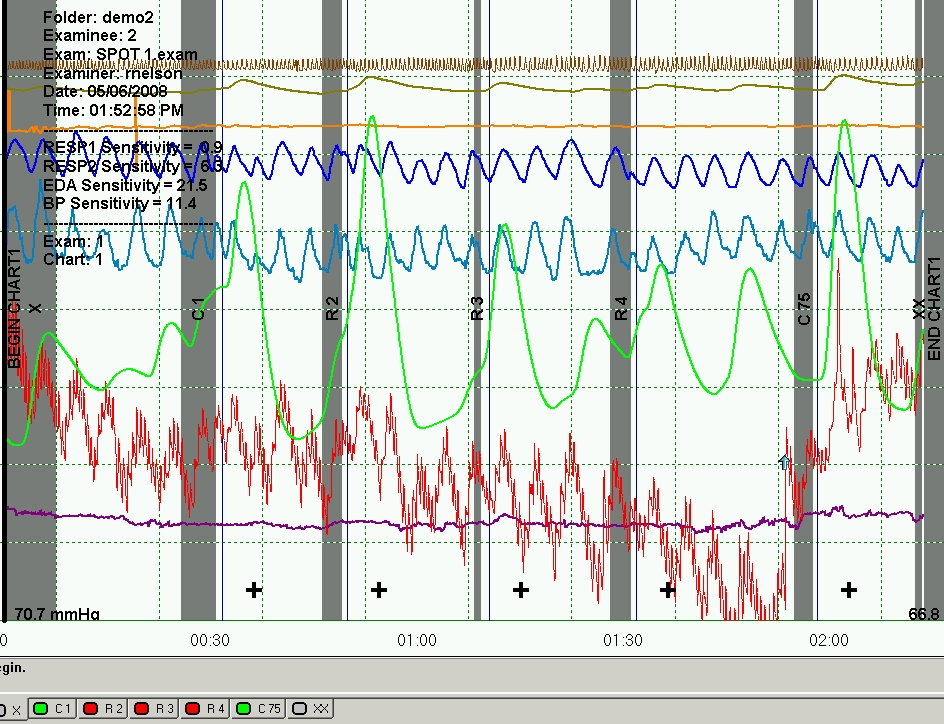

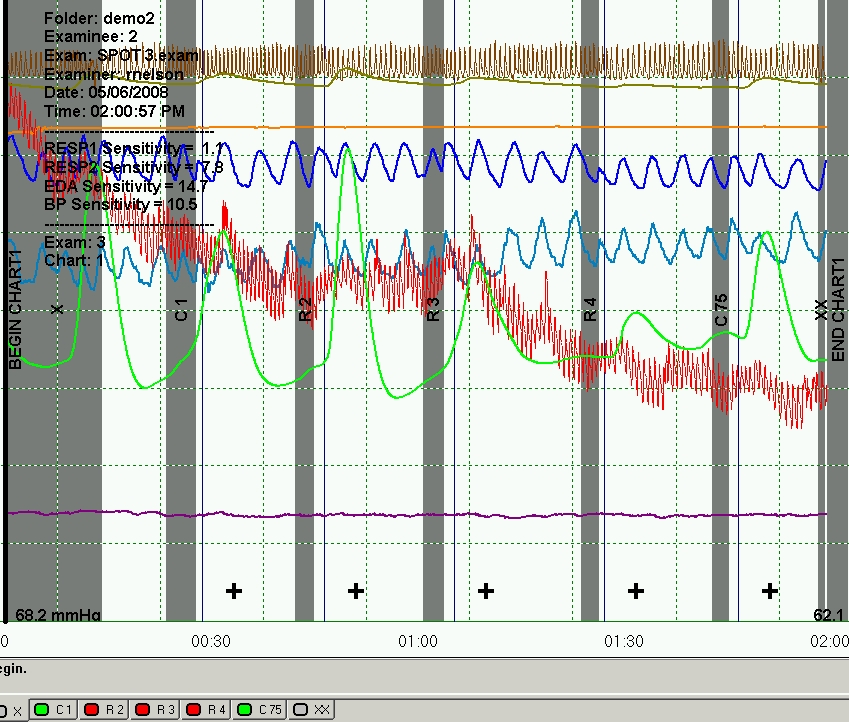
r
------------------
"Gentlemen, you can't fight in here. This is the war room."
--(Stanley Kubrick/Peter Sellers - Dr. Strangelove, 1964)
IP: Logged |
rnelson
Member
|
 posted 05-07-2008 11:05 AM
posted 05-07-2008 11:05 AM
  
Suspect #3Again three test series, with three separate keys. Include the last question in the analysis, and locate all keys at R3. 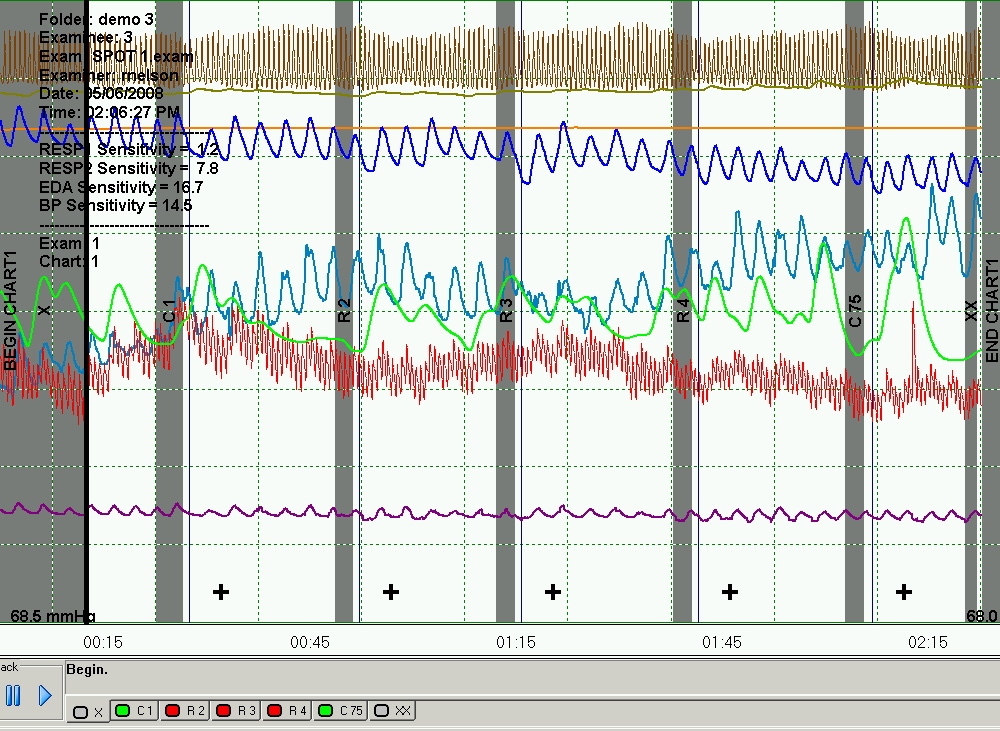
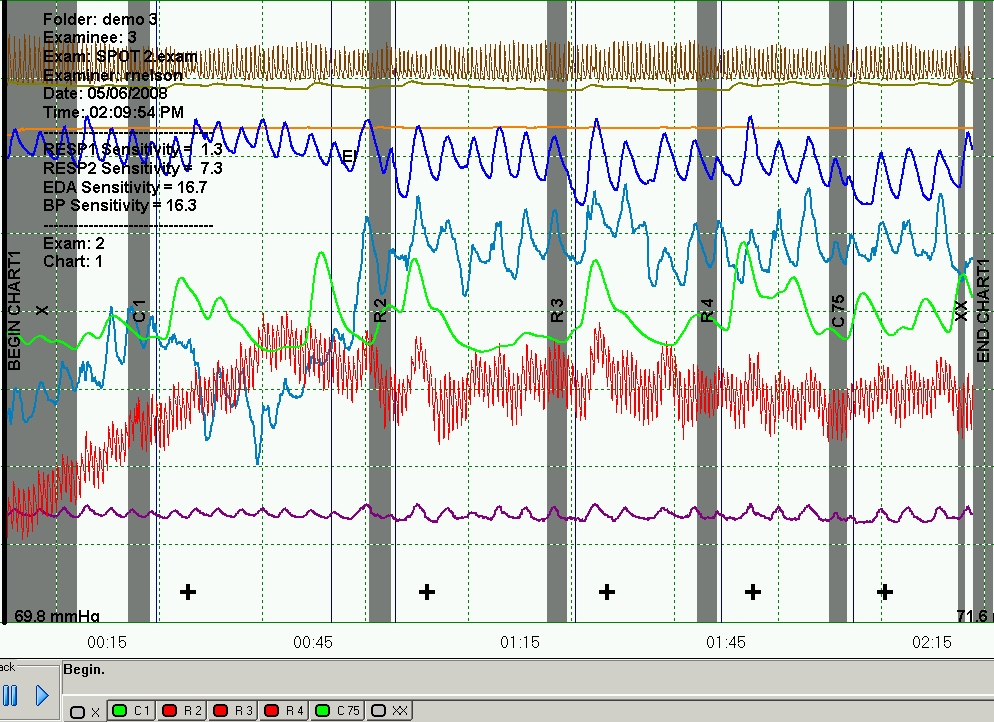

r ------------------
"Gentlemen, you can't fight in here. This is the war room."
--(Stanley Kubrick/Peter Sellers - Dr. Strangelove, 1964)
IP: Logged |
Gordon H. Barland
Member
|
 posted 05-07-2008 04:25 PM
posted 05-07-2008 04:25 PM
 
Raymond, I’m a believer in the value of interpreting charts within the context in which they were gathered. That’s why I’m a firm supporter of digitally video recording examinations. One quick example, then I’ll get to the questions I have. When I was reviewing a set of charts in a court case, I found several movement artifacts, generally consistent with low level CMs. However, what perplexed me was that they were occurring randomly, without regard for the question type or even whether a question was being asked. Perhaps the examinee’s goal was not to look NDI, but was trying for an inconclusive result. Yet, the charts scored out NDI if you overlooked the movements. When I received the video, I saw there was a fly in the exam room, and whenever the fly alit on the examinee’s head, he shook it off! My point is that context can be crucial for chart analysis. Now to my questions. 1. Am I correct in assuming that brown is plethysmograph, the “straight” brown line is an oximeter, and purple is the movement pad? What, then, is the orange line? 2. Because you said the tests were CITs (though they’re labeled SPOT), am I correct in assuming that each of the three charts from a given subject had a different set of questions? (If it was a SPOT test, I would assume the questions were the same from one chart to the next). 3. Were the questions on chart one the same for each of the three subjects? Or was each subject potentially guilty of a different act? 4. What was the nature of the act(s)? What instructions did you give them? 5. Is only one examinee lying to the relevant item(s), or could two or perhaps all three be guilty? 6. What were the padding questions? Is there any reason for not telling us the relevant questions? 7. Finally, and most importantly, was each examination independent of the others, or could the three subjects have colluded in deciding who was going to be guilty or what strategy they would apply to confuse you? Subject 3 was clearly manipulating his/her abdominal respiration, though whether it was a deliberate CM or sheer nervousness (perhaps stifling laughter?) might depend upon the context. Why was the audience allowed to interact with the examinees? I’m not trying to be difficult; without context, I feel like a fish out of water. I like these exercises you put up here. Keep them coming! Gordon
IP: Logged |
rnelson
Member
|
 posted 05-07-2008 06:42 PM
posted 05-07-2008 06:42 PM
  
Gordon,You are correct. They are incorrectly labeled as SPOT, when they are CIT. The brown cardio-like tracing is the Pulse Oximiter (P02). The other brown is the unfiltered EDA. I want to always record unfiltered EDA. Not sure why, but may I'll want to analyze it later. This is silly, because I'll probably not analyze my own charts. I've advised Limestone they should always record the raw EDA. At present it is not recorded if it is not displayed. Purple is the pneumatic CM sensor. Orange is the piezzo. I've been collecting data with both, but the gain/zoom is turned down low on the piezzo for these charts. The data are recorded normally, so it makes no difference. All question are the same for charts 1, 2, and 3 for all three subjects. For my own convenience, I put all the keys in R3. I set the templates up incorrectly. CIT should have 1 RQ and several padding Qs. It is the POT that has several RQs. In these tests, the last CQ has the same signal value as all the other padding Qs. Only the first Q should be ignored. Time is the only reason I didn't put up more info earlier. I put my driver's license, visa card and $100 in a business-card wallet, bound with a rubber band, and hidden in the second desk drawer in the office of a friend who is a professor at the graduate school of social work, at the University of Denver (DU). The class is a higher level course on managing angry and dangerous clients, available to graduate students nearing the end of their course-work. I taught this class one semester, a couple year ago, and I'd love to do it again. Volunteers were requested to take a demonstration polygraph test, as long as each volunteer was willing to commit a crime. Three unmarked sealed envelopes were prepared. Its a three hour class, and they were told to complete the instructions before the last hour of class, which includes one break. One participant was instructed to finde the office, look in the desk drawer, open the wallet, find the contents, and keep all the items on their person. 2nd subject was sent to the restroom with instructions to return in 5 min. 3rd was told to go outside and walk around the building. All were instructed to not get caught. First test is location 1. car
2. cash-register
3. office
4. classroom
5. hallway Second test is item 1. watch
2. computer
3. wallet
4. Blackberry
5. iPod Third test is how it was secured 1. key-lock
2. combination lock
3. rubber band
4. password
5. bungee cord I had a forth test series (item stored) which was not used. 1. counter
2. file cabinet
3. desk drawer
4. file cabinet
5. storage locker All the key items are in position 3. It doesn't have to be that way. I've done this two or three other times for probation, involving instructions to go outside and find my car, and then remove a watch from a briefcase that is tied shut with a necktie. That one uses 5 keys and 5 tests, and takes more time. Sorry for the confusion. This was a fun experiment, because Social Workers are not trained in testing, and are almost taught to be suspicious of objective testing (crazy, I know). They consider themselves to be intuitive people who "know by observing and listening." Immediately after this experiment, we had the classroom score the data to the correct conclusion. I have hand-scores and the results of a CIT algorithm which I've given to Limestone and Lafayette. r ------------------
"Gentlemen, you can't fight in here. This is the war room."
--(Stanley Kubrick/Peter Sellers - Dr. Strangelove, 1964)
IP: Logged |
Gordon H. Barland
Member
|
 posted 05-08-2008 07:14 AM
posted 05-08-2008 07:14 AM
 
Raymond,Thanks for the wealth of detail. One last question before I evaluate the charts, which affects the response window onset. Did the Subjects know the question seequence beforehand? For example, some examiners post a list of the items in proper sequence on the wall in front of the Subject. Gordon IP: Logged |
rnelson
Member
|
 posted 05-08-2008 08:00 AM
posted 05-08-2008 08:00 AM
  
Gordon,I read the subjects the question list before beginning each test. I really did not emphasize that, and wondered later whether I should have telegraphed the question sequence more aggressively. I've done three previous demonstrations of this type, and this one is not as clear. The number of keys is reduced for this one, as are the number of padding questions. For the purpose of this test, I set alpha at .1 Subject #1 took a deep breath at question 2 causing a EDA reaction and corresponding depression in the cardio tracing. I ignored this segment, and admonished the subject. All three subjects are female, late 20s and early 30s. Non-athletic type persons. r
------------------
"Gentlemen, you can't fight in here. This is the war room."
--(Stanley Kubrick/Peter Sellers - Dr. Strangelove, 1964)
[This message has been edited by rnelson (edited 05-08-2008).] IP: Logged |
rnelson
Member
|
 posted 05-08-2008 09:33 AM
posted 05-08-2008 09:33 AM
  
*** Spoiler Alert ***These links have the scored results
http://www.raymondnelson.us/graphics/050708/CIT1.jpg
http://www.raymondnelson.us/graphics/050708/CIT2.jpg
http://www.raymondnelson.us/graphics/050708/CIT3.jpg As Gordon pointed out, the question templates are formluted incorrectly as SPOT, when they are CIT. Retagging the Qeustions fixes the compliance
http://www.raymondnelson.us/graphics/050708/050708_CIT_1.jpg
http://www.raymondnelson.us/graphics/050708/050708_CIT_2.jpg
http://www.raymondnelson.us/graphics/050708/050708_CIT_3.jpg peace, r ------------------
"Gentlemen, you can't fight in here. This is the war room."
--(Stanley Kubrick/Peter Sellers - Dr. Strangelove, 1964)
IP: Logged |
blalock
Member
|
 posted 05-08-2008 09:52 AM
posted 05-08-2008 09:52 AM
  
Ray,You are doing some amazing things. the CIT has got to be one of the most under-utilized tools in polygraph.
------------------
Ben blalockben@hotmail.com IP: Logged |
Gordon H. Barland
Member
|
 posted 05-08-2008 10:32 AM
posted 05-08-2008 10:32 AM
 
Raymond, Using the Lykken scoring system, (GSR amplitude only; scores of 2-1-0) Subject 1 scored -4, DI. That assumes that you zero out the GSR on Chart 2’s R2 because of the deep breath, and that the R3 GSR is valid (not premature) because she knew the question sequence in advance. I went with these latter two assumptions because she was an excellent plethysmic reactor, hitting R3 on all three charts. Aside from the initial buffer, the greatest/longest constrictions were on R3, and there was a trend toward dilatation (relaxation) for the remainder of the chart. Therefore I’m confident S1 the critical items had salience. S2’s GSR scored -3, which by Lykken’s scoring is also DI, but in my opinion it is not supported by the other channels. My initial look at S3 was that with all that distortion in her abdominal respiration, she is likely trying to manipulate the results. But her Lykken score is 1 ½ (NDI), for on chart 3 her R3 amplitude is tied for 1st place with R4. I found it interesting that nobody reacted to the critical item on chart 1. I apologize for using the terms DI/NDI on a CIT. I’m old school. Gordon
IP: Logged |
rnelson
Member
|
 posted 05-08-2008 11:47 AM
posted 05-08-2008 11:47 AM
  
Subject #1 was guilty.Subject #3 adamantly denied manipulating her breating. I am not convinced. I'm also suspicious about some collusion with Subject #1, to dry to distract the test result. It was a good day. I'm still not happy with the report. The content includes and marked artifacts or edits to the data, for auditing and QC. However, CIT includes three separate Key items, which are reported as three RQs. The Question tags in the probability tables, for test series and components is confusing because it presently displays the original RQ position and tag. It might be better to change the column heading to "Key item." Any suggestions are welcome. CIT makes a good demonstration test. So I'd like to find a solution that doesn't completely telegraph the key, even if the question template/list is projected onto a screen for a group of observers. The report should clearly identify the key. Also, the keys will often be placed in different positions.
r

------------------
"Gentlemen, you can't fight in here. This is the war room."
--(Stanley Kubrick/Peter Sellers - Dr. Strangelove, 1964)
[This message has been edited by rnelson (edited 05-08-2008).] IP: Logged |
Gordon H. Barland
Member
|
 posted 05-08-2008 04:59 PM
posted 05-08-2008 04:59 PM
 
Oh, Jeez! For what it’s worth, I didn’t see Ray’s posting of the OSS scores or Ben’s comment before I hit the “submit” button with my conclusion. I just took too long to score the charts and compose my comment. Frankly, I thought a dozen others would weigh in before Ray gave us ground truth. Where were you Stat, Donna, & Ted? Gordon
IP: Logged | |


 Polygraph Place Bulletin Board
Polygraph Place Bulletin Board

 Professional Issues - Private Forum for Examiners ONLY
Professional Issues - Private Forum for Examiners ONLY

 Whodunnit?
Whodunnit?














